Standard [WITHDRAWN] Article is not orderable
ASTM F 1743:2024
Standard Practice for Rehabilitation of Existing Pipelines and Conduits by Pulled-in-Place Installation of Cured-in-Place Thermosetting Resin Pipe (CIPP)
- Publication date
- 2024
- Original language
- English
- Pages
- 9
- Publication date
- 2024
- Original language
- English
- Pages
- 9
- DOI
- https://dx.doi.org/10.1520/F1743-24
Product information on this site:
Quick delivery via download or delivery service
Buy securely with a credit card or pay upon receipt of invoice
All transactions are encrypted
Short description
1.1 This practice describes the procedures for the reconstruction of pipelines and conduits (2 in. to 96 in. (5 cm to 244 cm) diameter) by the pulled-in-place installation of a resin-impregnated, flexible fabric tube into an existing conduit and secondarily inflated through the inversion of a calibration hose by the use of a hydrostatic head or air pressure (see Fig. 1 ). The resin is cured by circulating hot water, by the introduction of controlled steam into the tube, or by photoinitiated reaction. When cured, the finished cured-in-place pipe will be continuous and tight fitting. This reconstruction process is suitable for use in a variety of gravity and pressure applications such as sanitary sewers, storm sewers, building piping, process piping, electrical conduits, and ventilation systems. 1.2 The values stated in inch-pound units are to be regarded as standard. The values given in parentheses are mathematical conversions to SI units that are provided for information only and are not considered standard. Note 1: There are no ISO standards covering the primary subject matter of this practice. 1.3 The text of this standard references notes and footnotes which provide explanatory material; these notes and footnotes (excluding those in tables and figures) shall not be considered as requirements of the standard. 1.4 This standard does not purport to address all of the safety concerns, if any, associated with its use. It is the responsibility of the user of this standard to establish appropriate safety, health, and environmental practices and determine the applicability of regulatory limitations prior to use. 1.5 This international standard was developed in accordance with internationally recognized principles on standardization established in the Decision on Principles for the Development of International Standards, Guides and Recommendations issued by the World Trade Organization Technical Barriers to Trade (TBT) Committee.
ICS
23.040.20
DOI
https://dx.doi.org/10.1520/F1743-24
Replacement amendments
This document has been replaced by: ASTM F 1743:2025 .
Also available in
Loading recommended items...
Loading recommended items...
Loading recommended items...

